An Evaluation of Legacy from the Glasgow 2014 Commonwealth Games: Post Games Report
This report is the first post games legacy evaluation report for the XX Commonwealth Games it aims to generate learning for ourselves, future bidders and hosts, and to add to the international literature
4. Active Legacy
4.1 This chapter sets out the evidence to date which helps answer the following question set out in the Pre Games Report:
What effect have the Games had on active infrastructure, sports participation and physical activity?
4.2 In particular, the chapter focuses on the contribution of the Glasgow 2014 Games to outcomes of improvement in sporting and physical activity infrastructure; promotion of sports participation and physical activity and improvement in Scottish sporting success.
4.3 Promoting an active legacy from the Commonwealth Games is an important legacy theme common to both the Scottish Government and Glasgow City Council. The intention was to maximise the potential of the Games to support more active lifestyles, help Scotland achieve its vision of more people, more active, more often, and contribute to the development of high performance sport in Scotland.
The wider evidence base
4.4 An update to the evidence review that accompanied the Pre Games Report shows that while major sporting events commonly leave an infrastructure legacy, and there can be a boost to host nation sporting performance, the evidence for a relationship between hosting major sporting events and improving population level sports participation and physical activity remains mixed and inconclusive. What remains clear is that such impacts do not arise as an automatic result of hosting a large sporting event.
Infrastructure
4.5 The literature cites the risk of event venues becoming ‘white elephants’ with potential to exclude surrounding communities from access rather than serving to enhance local sport and physical activity facilities. Careful planning and embedding of legacy activities in existing strategies on sport and physical activity are required alongside a comprehensive and cohesive long-term vision for event venues.
4.6 This ‘white elephant’ risk is thought to have become less of an issue as awareness has increased of the importance of early planning for post Games use. Despite best intentions, however, there can still be problems with venue handling post-Games. For example, although all eight venues for the London Olympics now have their futures secured, there remain some concerns over access to these facilities by the surrounding communities, access for the disabled and those on low incomes.[35]
4.7 There is no inevitable improvement of grassroots active infrastructure related to hosting major multi-sports events. Some research has found potential tensions between funding the infrastructure required for elite competition sport and investment in community grassroots infrastructure.
Participation
4.8 The evidence review highlights how sports participation and physical activity are often assessed using population level surveys tracking a ‘before’ and ‘after’ snapshot. This type of evidence has revealed a mixed picture in relation to the Sydney 2000 Olympics (mixed/inconclusive), Barcelona 1992 Olympics (positive but disputed), and Melbourne 2006 and Manchester 2002 Commonwealth Games (negative).
4.9 The meta-evaluation of the London 2012 Olympic legacy reported increases in sport participation which was attributed to the impact of the event and associated legacy programmes. Subsequent data have shown some decline in sport participation figures, though much of the increase since 2005/6 has been retained.[36] The House of Lords Select Committee report on Olympic and Paralympic Legacy interpreted this data as evidence that a step-change in participation levels has not occurred.
4.10 A study of the impact of hosting the Winter Olympics in Vancouver in 2010 on physical activity and sports participation in a representative sample of Canadian young people aged 5-19 years showed no change during or post Games compared to previous years.
4.11 Theories on how major sporting events impact on population participation tend to focus on individual level factors. It is suggested that major sporting events can influence sport and physical activity participation through a ‘demonstration effect’ i.e. inspiring increased frequency of participation by existing sports participants; renewed participation in lapsed participants and new sport uptake by existing participants.
4.12 There may also be a ‘festival effect’ whereby those not interested in sport and not very active consider undertaking more activity, influenced by the wider celebrations, cultural activities and community events.
4.13 The updated literature review found no new empirical evidence that examined either of these theories in relation to hosting mega sports events. However, there is some evidence from a study of spectators at smaller single sports events in the UK suggesting a positive influence on intention to participate more in sport with an impact on both those already active and those who were previously uninvolved in sport. It is not known how well that intention translates into actual action.
4.14 In summary, the weight of evidence that there is no automatic effect on population levels of sporting participation (let alone wider physical activity) from hosting major sporting events has grown over the last year. Some boost in interest in sport among some groups is plausible and consistent with the theory of a demonstration effect. Thus, the message remains unchanged that increased sports participation and/or physical activity is not an automatic result of hosting a major sporting event, but is instead affected by a multitude of individual level, social and environmental factors.
Performance
4.15 Evidence of how hosting a major sporting event impacts on the sporting performance of the host nation is limited. Elite sporting success is influenced by many factors beyond the control of government. There is evidence from the evaluation of the London Olympics 2012 that the performance of Team GB was enhanced as a result of London hosting the event. This was considered to be a result of increased funding, performance development programmes which led to more careful monitoring, improvement in talent identification, greater support for elite athletes, sports and science medicine and elite coaching development.
Glasgow 2014 Legacy Programmes and Investments
4.16 The Scottish Government and Glasgow City Council focussed on using the Games as a catalyst for enhancing and accelerating existing policies and interventions on sport and exercise participation and physical activity more broadly. This was based on the understanding that interventions here – such as enhancing the grassroots infrastructure and improving PE in schools – are required for any long term impact on active infrastructure and population activity levels.
4.17 Figure 4.1 below presents a distillation of the large number of investments and programmes across Scotland and Glasgow that were put in place to capitalise on the Games and help contribute to a lasting legacy. These include leveraging multiple benefits from the investment in Games venues, investing and building capacity in the grassroots active infrastructure, enhancing population activity outcomes through long term policy and delivering a high performance sport programme.
Figure 4.1. Key Active Legacy Interventions
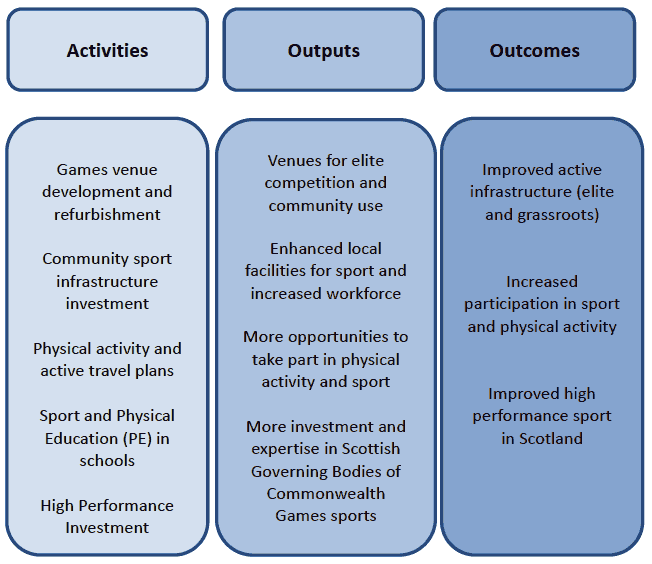
Evidence to date of Games effect
Infrastructure
4.18 Scotland’s high performance sport infrastructure has been enhanced since 2008. While 70% of the required venues were in place at the time of bidding, significant public investment to build new and refurbish existing venues was still required. As a result of this investment, facilities that are of a standard to host international competition have been developed across a range of sports including swimming, diving, cycling, bowling, hockey and badminton. This has contributed to an enhanced ability to attract international events and competitions, as discussed in the previous chapter.
4.19 New venues include the Emirates Arena and Sir Chris Hoy Velodrome, the Glasgow National Hockey Centre, Kelvingrove Bowls Centre and a venue for mountain biking at Cathkin Braes on the outskirts of Glasgow. Refurbished and adapted venues included Scotstoun Sports Campus (where the Squash and Table Tennis competition took place), Tollcross International Swimming Centre, the Royal Commonwealth Pool in Edinburgh (diving) and Hampden Park (athletics).
Figure 4.2. Hampden Park at Games Time
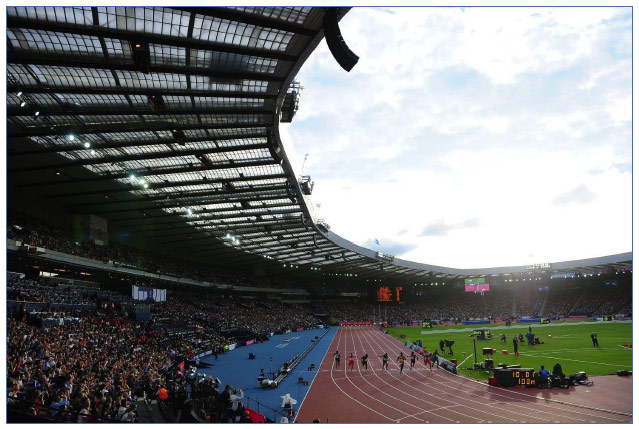
Getty Images
4.20 For the new and significantly refurbished Games venues in Glasgow, an important early strategic decision was made that these would be multi-sport venues that were capable of both hosting major events for a range of sports and providing opportunities for the local community.[37] To that end, business plans for these venues were put in place that set out how the twin objectives of creating high quality environments in which performance athletes could train and compete and facilities for widening community engagement in active recreation and sport were to be achieved.
4.21 In accordance with this strategy, all new and refurbished Games venues were completed and opened to the public in advance of the Games. In addition, effort was made to ensure rapid reopening post Games and all venues were once again available to the public within 12 weeks of the Closing Ceremony.
4.22 Early evidence is that Games venues are managing to balance competing needs of and demands for facilities by clubs, events, elite training and the public. An evaluation of five key venues[38], indicates that there has been significant increases in community use and user satisfaction with Games venues. For example, attendances at the Emirates Arena were up 71% in January-March 2014 compared with the same period in 2013 and Scotstoun attendances were up by 29% in 2013 compared with 2012.
Figure 4.3. Sir Chris Hoy Velodrome at Games Time
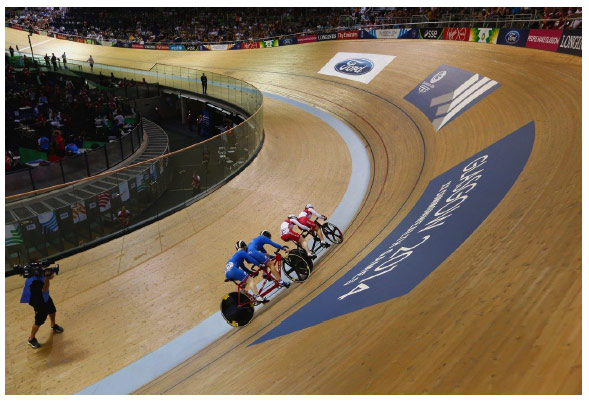
Getty Images
4.23 Increases in satisfaction with the facilities amongst users are also clear. Ninety-eight per cent of casual users of Scotstoun rated the facilities as very good or good post refurbishment, compared to 73% pre-investment. Similarly, 100% of casual users rated Tollcross as good or very good post-investment, compared to 55% pre investment.
4.24 The same evaluation states “feedback from sporting governing bodies was unanimous that the investment had created flagship venues that meet the needs of all customers – from public use to the high standard of facilities required by talented and elite athletes for training and competition”.[39]
4.25 At a grassroots level throughout Scotland, several of the legacy programmes focussed on infrastructure improvement including the Legacy Active Places Fund; Community Sports Hubs; and the Supporting Coaches and Volunteers programme.
4.26 The sportscotland managed Legacy 2014 £10 million Active Places Fund provided grants to communities to help create or improve places where people can get active, for example, a new skate park, outdoor adventure facility or walking route. Over 150 awards were made across all local authorities in Scotland, with some facilities complete and open for use and others in development.
4.27 sportscotland have also been working with all 32 local authorities across Scotland to invest National Lottery money to ensure at least 150 Community Sports Hubs are in place by 2016. Such hubs provide homes for local clubs and sports organisations and are based in local facilities like sports centres, community centres and schools. To date, 142 Community Sports Hubs are operational across Scotland, with more than half based in schools. Monitoring data shows that at the end of 2014/15, there were 994 individual clubs with 114,577 members participating in 49 sports across Scotland’s 32 local authorities.
4.28 An evaluation of Community Sports Hubs found evidence that hubs have contributed to improved collaboration between clubs in local areas, increased awareness and recognition of the value of sport in communities and some increased participation in sport. Less evidence was found of wider community engagement, beyond the club environment. Hub officers recognised that wider community engagement, particularly with those not engaged in sport, is more challenging and a focus of the next phase of hub development.[40]
4.29 The evaluation also found some evidence that Community Sports Hubs have contributed to the development of the ‘people’ aspect of Scotland’s active infrastructure. Over 9,000 individual deliverers of sport are involved in Hubs across Scotland. Stakeholders and hub officers observed the programme has supported the development of young sports leaders and expanded the skills of club leaders through new voluntary opportunities, including roles on management committees, steering groups, membership of Executive Boards and running facilities.
4.30 The Coaches and Volunteers legacy programme was designed to help the Scottish Governing Bodies of the 17 Commonwealth Games sports in Glasgow 2014 have sufficient high quality coaches, volunteers and officials to help widen and sustain participation. Data indicates that over 20,000 UK Coaching Certificate qualifications have been awarded in Scotland since 2008.
4.31 There is also evidence of enhanced capacity within the community sports sector in Glasgow. Glasgow Life[41] legacy programmes were designed to increase capacity to respond to any increased interest in sport related to the Games. These programmes have provided support to local voluntary clubs to improve quality, grow membership, recruit volunteers and train coaches. The number of clubs working with Glasgow Life has more than doubled, from 327 in 2009/10 to 791 in 2014/15. This growth in clubs supported has resulted in a corresponding increase over the same period in the number of volunteers (from 2,139 to 4,353); coaches (from 2,018 to 4,044) and club members (from 4,485 to 19,361) which are benefitting from Glasgow Life support.
4.32 In addition to the evidence above of enhanced performance and grassroots infrastructure in Scotland, there is evidence of increased use of, and satisfaction with, the active infrastructure in Glasgow and Scotland in recent years. Attendance at leisure facilities has increased year on year in Glasgow and Scotland since 2010/11 and Glasgow attendance now surpasses the Scotland rate (see Participation section below).
4.33 Satisfaction across Scotland with local sports facilities amongst users increased from 83% in 2008 to 88% in 2013[42]. At a Glasgow level, satisfaction was higher than the national level at 89% in 2008. Levels of satisfaction increased to 92% in 2011 and have returned to 89% in 2013. This may be reflective of some of the disruption that users will have experienced as a result of preparation for the Games.
4.34 Much of this increase in use of and satisfaction with local sports facilities is likely to be related to improvements in the core mainstream provision of Local Authority leisure services, which have seen significant increases in capital investment over the last ten years[43]. It is plausible that the Games related improvements in infrastructure have complemented and contributed additional impetus to these increases in use and satisfaction.
Participation
4.35 As noted above, the prospective assessment of the Pre Games Report was that automatic population level increases in participation in sport and physical activity were unlikely. Increased participation among certain groups – particularly those already involved in sport to some extent – were thought plausible through the operation of a ‘demonstration effect’.
4.36 A demonstration effect is said to operate when major sporting events inspire increased sports participation in three ways: increased frequency of participation by existing participants; renewed participation in lapsed participants and existing participants inspired to try new sports.
4.37 There is some limited data that suggests a demonstration effect may have operated in relation to the Commonwealth Games. sportscotland figures indicate that membership of clubs in the 17 Commonwealth Games sports has increased since 2011/12. Overall, figures indicate an 11% increase in membership of the 17 Commonwealth Games sports governing bodies over the past four years. This includes notable increases in certain sports – 58% rise in membership of Netball Scotland, 49% rise in Triathlon Scotland and 37% rise in Scottish Gymnastics.
4.38 Membership of the Glasgow Club health and fitness network has also increased. Glasgow Club members can use 22 gyms and 12 swimming pools across the city, including new and refurbished Games venues at the Emirates Arena, Tollcross International Swimming Centre and Scotstoun Leisure Centre. Numbers of Glasgow Club members has increased from 24,000 in 2012 to 40,000 in June 2015[44].
4.39 As mentioned above, attendance at Local Authority leisure facilities across Glasgow and Scotland has increased. Increases in Glasgow have been larger than the national average, and for the first time since 2011/12, attendance per 1000 population is now higher in Glasgow than the Scotland average. Attendances at leisure facilities in Glasgow increased from 6,855 per 1,000 population in 2008/9 to 10,461 per 1,000 population in 2013/14 – an increase of 53% (see Figure 4.4).
Figure 4.4. Number of attendances per 1,000 population at leisure facilities, including swimming pools
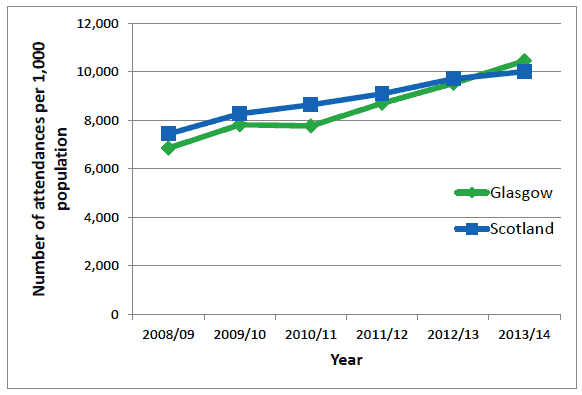
Source Audit Scotland
4.40 These increases in membership and attendance do suggest increased interest in sport and exercise, and the notable increases in certain Commonwealth Games sports and above average increase in attendance in Glasgow suggest it is plausible that the build-up to, and high profile of the Games has been a contributing factor.
4.41 Membership and attendance data is limited, however, in its ability to shed light on whether actual participation in sport and physical activity is growing at a population level (either frequency of participation, or growth of new participants). It is possible to be a member of a club and not participate frequently, and, of course, participate in sport without being a member of a club. A number of Commonwealth Games sports (including, for example, netball and triathlon) are very much niche interests at a population level and so even large increases in membership would not be expected to translate to population level increases in participation. Attendance figures tell us the total number of visits to sport and leisure facilities, but not the total number of individual users.
4.42 The most robust population level data we have on participation in sport and exercise is from national population surveys – the Scottish Household Survey and Scottish Health Survey. The most recent data from the Scottish Household Survey did show an increase in participation in sport and exercise from 73% in the baseline year of 2008 to 78% in 2013 – largely driven by an increase in recreational walking. The trend of increasing frequency of participation among sport and exercise participants noted in the Pre Games report also continued in 2013. The literature on the demonstration effect suggests some effect can be seen in the build-up to a major event or ‘pregnancy’ period, and it is possible that some of the increased participation is attributable to this.
4.43 It is too soon to say from national survey data whether any inspirational effect from the Games will help continue this trend of increased participation frequency, or even impact on population sports participation among non-participants. There is evidence that participants in some of the community events surrounding the Games anticipated they would increase their participation.[45] Future data will give insight into whether this translates into sustained changes in behaviour.
4.44 Further, the evidence suggests that demonstration effects can be short term, and do not impact on those uninterested in sport. Any attempt to drive longer term change in participation and widen participation to those not interested in sport requires plans to increase the infrastructure available to encourage and support sustained increases in non-sport physical activity.
4.45 This was the approach taken in national and city legacy programmes. These programmes focus on physical activity more broadly. At a national level, the key legacy programme is the 2014 Physical Activity Implementation Plan, “A More Active Scotland: Building a Legacy from the Commonwealth Games”.[46] This 10 year plan adapts key elements of the Toronto Charter for Physical Activity[47] and links it directly to the Scottish Government’s legacy ambitions for the Commonwealth Games. Actions are set out in five settings – environment, workplace, schools, health and sport and active recreation.
4.46 Key developments on the Physical Activity Implementation Plan (PAIP) since its launch include the publication of Scotland’s first National Walking Strategy[48], which includes actions for improving the environment for walking. A cross-sector delivery group, chaired by the Director of the Royal Town Planning Institute Scotland, has been established to oversee implementation of these actions.
4.47 Transport Scotland have published a new Long Term Vision for Active Travel[49] to encourage more walking and cycling for everyday short journeys. A new National Planning Framework,[50] which includes developments to promote physical activity, has also been published. All of these developments include actions contained in existing NICE guidelines for increasing physical activity[51] such as wider implementation of 20mph zones.
4.48 Similarly, actions in the PAIP to improve physical activity via the health sector are being overseen by a new Health and Social Care Delivery Group, chaired by the President of the Royal College of Surgeons Edinburgh. These actions include developing the Physical Activity pathway for use by health professionals, enhancing the health estate[52] in Scotland to make it more enabling of physical activity and encouraging the health and social care workforce in Scotland to be more active.
4.49 Finally, at an overarching strategic level, the National Strategic Group for Sport and Physical Activity, chaired by the Cabinet Secretary for Health, Wellbeing and Sport, have agreed a new Active Scotland Outcomes Framework.[53] The National Strategic Group comprises the chief executives of Scotland’s public bodies in health, sport, education, transport, environment; political and official representation from local government and academic representation.
4.50 The framework articulates a number of high level outcomes required to make progress on the overall long term goal of increasing the proportion of the population sufficiently active for health. It also recognises that reaching the very inactive (those active for less than thirty minutes per week) is particularly challenging.
4.51 Our collective understanding of the evidence on physical activity in Scotland has developed considerably in the last year with the publication of the Physical Activity Topic Report[54] and evidence review on enabling the inactive to become active[55]. Through this we know, for example, that the risk of being in the inactive group is much higher among those with a disability and/or long-standing poor health and older age groups. This suggests the PAIP actions being overseen by the Health and Social Care Delivery Group will be particularly important for reaching the inactive.
4.52 Data from the Scottish Health Survey indicate that nationally, 2013 saw the first increase in physical activity in adults for a number of years. In 2013, 64% of adults in Scotland met the new moderate to vigorous physical activity (MVPA) guidelines compared to 62% in 2012. An increase was also observed for Greater Glasgow and Clyde (66% in 2013 compared to 62% in 2012), although the difference was not statistically significant.
4.53 Future years of data will be required to determine whether this is the beginning of a positive trend. The increase in adults physical activity was in men only and not observed for women, and involved an increase in those doing some activity to doing sufficient activity to meet the guidelines. There has been no change in the proportion of the population who are very inactive.
4.54 The Sport and PE in Schools Programme is the key national legacy programme aimed at children and young people, and a key setting for continued actions set out in the Physical Activity Implementation Plan. It is a ‘whole school’ approach to improving physical education, physical activity and sport in schools. Interventions to support the delivery of the target 2 hours/2 sessions of PE in primary and secondary schools is complemented by the Active Schools programme of extra-curricular sport and physical activity classes around the school day.
4.55 sportscotland is investing £6.8 million in local authorities over 2012/13 – 2015/16 to help them to deliver at least two hours of quality PE in primary schools and two periods in secondary schools, for pupils in S1 – S4. Education Scotland is supplementing that with a £4.8 million package of national initiatives designed to increase the support available to schools and teachers. This has included support for a network of 39 PE Lead Officers (PELOs) working across local authorities, the roll-out of the Better Movers and Thinkers (BMT) physical literacy programme, a PE Grants fund and disability inclusion training involving teachers, local authority education departments and tertiary education establishments.
4.56 An external evaluation concluded that all of these initiatives have made a positive contribution to the quantity and quality of PE provision in schools in Scotland.[56] The PELOs and BMT programme have had a particularly notable impact in terms of scale, difference made to teachers’ learning and teaching practice and the opportunities for children and young people to experience quality PE. A majority of teachers surveyed agreed the programme contributes to a number of outcomes, including achieving the schools Health and Wellbeing priorities (75%), greater engagement in PE by children and young people (74%) and helping the school provide the target two hours/two periods of PE for each pupil every week (72%).
4.57 Statistics published in June 2015 show that 98% of all primary and secondary schools are now meeting the PE target, up from 10% in 2004/05.[57]
4.58 The evaluation highlighted some ongoing challenges for the programme including ensuring PE provision across all schools is of uniformly high quality; involving parents and the wider community in measures to promote children’s engagement in PE, physical activity and sport and ensuring the role and remit of Active Schools co-ordinators focuses on the provision of extra-curricular activities around the school day.
4.59 An evaluation of the Active Schools programme published in October 2014 found that overall, the programme has expanded considerably, operates across all 32 local authority areas and delivers its core aim of introducing more and better opportunities for young people in sport and wider dance, play and exercise activity.[58]
4.60 In 2013/14, pupils undertook 5.8 million visits to Active Schools supported activity – an increase of 15% since 2012/13. Some Active School teams felt the Commonwealth Games had stimulated additional demand for new sports and activities. The evaluation also found that Active Schools plays a role in growing the ‘people’ side of the active infrastructure in Scotland. In 2013/14, more than 20,000 individuals contributed to the delivery of Active Schools activities – 84% on a voluntary basis.
4.61 Many Active School teams reported demand as being high amongst those already active to some extent. Local level planning data are critical to understanding who is not taking part in Active School activities. For example, the evaluation found that encouraging greater participation among girls and young women was facilitated by girls-only activity sessions, effective consultation, a range of activities (team and individual) and peer support.
4.62 Data from the Scottish Health Survey indicates that children’s physical activity levels increased in 2013. In 2013, when school-based activities were accounted for, 75% of children were active at the recommended level of at least 60 minutes a day every day, a significant increase on the figure for 2008 and 2009 (71%).[59] The long running gap between boys and girls physical activity levels, while still significant, has narrowed since 2008. The gap was six percentage points in 2013, down from 13 percentage points in 2008.
4.63 The overall decline in sports participation among children noted in recent years seems to have stalled in 2013, although a decline among girls continued. Girl’s adherence to the physical activity guidelines was, however, at its highest level in 2013, suggesting that the increased activity levels among girls has not been driven by increased participation in sports. It is plausible the wide programme of activities offered through Active Schools, including dance and exercise activities and girls only activity sessions, has contributed to this increase in girls in Scotland meeting physical activity guidelines. Within the Active Schools programme itself, the proportion of boys and of girls taking part is roughly equal.
Performance
4.64 The High Performance Sport programme aimed to increase the chances of individual and team success at the Glasgow 2014 Commonwealth Games and ensure success at future major sports events through investment in high performance infrastructure; expertise and targeted support to individual athletes.
4.65 For 2011-15 sportscotland invested over £38 million of Scottish Government and National Lottery funding into the Scottish governing bodies of sport responsible for the 17 Commonwealth Games sports and Scottish Disability Sport, a 23% increase compared to 2007-11.
4.66 Through Mission 2014 sportscotland ensured that the 17 sports had a clear performance plan in place for the Games. This planning framework will continue into future cycles, providing a clear methodology for major Games preparation.
4.67 sportscotland staff supported all 17 Games sports and their athletes across a range of disciplines, including: sports medicine, physiotherapy, performance lifestyle, programme design, sports science and strength and conditioning.
4.68 The sportscotland Athlete Personal Awards (SAPAs) was a three-year initiative which offered an annual financial award of £5,000 or £10,000 to individual athletes who were considered to have the potential to deliver a medal winning performance at the Glasgow 2014 Commonwealth Games.
4.69 These awards helped athletes cover training, competition and living costs, recognising that this financial support can be necessary for athletes looking to make steps towards medal success at major events. A total of 61 athletes across 14 sports received such awards. A further 30 athletes were supported by team awards to cycling, badminton and women’s hockey.
4.70 The standard indicator of elite sporting success nationally and internationally is the number of medals won in international sporting competitions. The intended outcome was for increased success for Scottish athletes at the 2014 Games and any future major sporting events, with the number of medals won by Scottish athletes at the Commonwealth Games providing an indicator of this success.
4.71 The impact of the Games on elite sport is clear, at least in the short-term. Team Scotland achieved their aim for the 2014 Commonwealth Games, to increase medals totals across the board.
4.72 Team Scotland, fielding their largest team ever with 310 athletes, secured 53 medals – 19 Gold, 15 Silver and 19 Bronze ranking 4th in the overall medal table (see Figure 4.5). This surpassed their Commonwealth Games target of breaking their previous record 33-medal haul of Edinburgh 1986. Four new commonwealth records were set by Scottish athletes. A total of 204 Scottish athletes broke into elite sport and made their Commonwealth Games debut .
Figure 4.5. Scottish medal haul in previous games
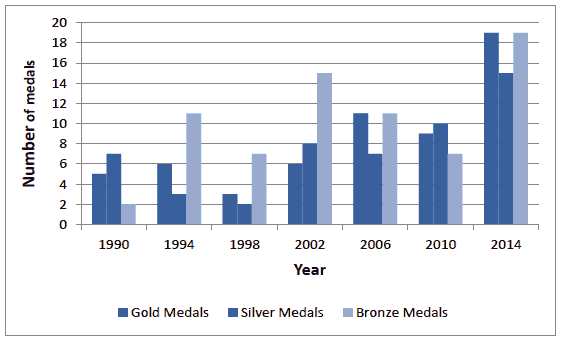
Source: Commonwealth Games Records
Contact
Email: Niamh O’Connor
There is a problem
Thanks for your feedback